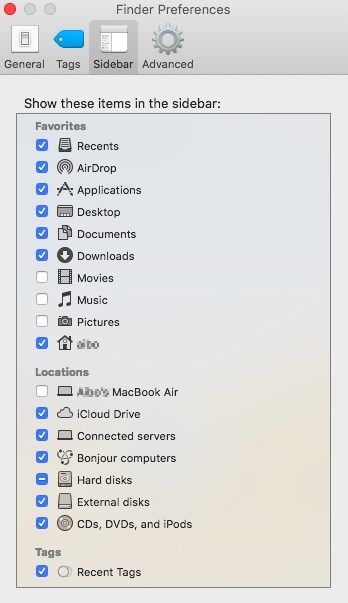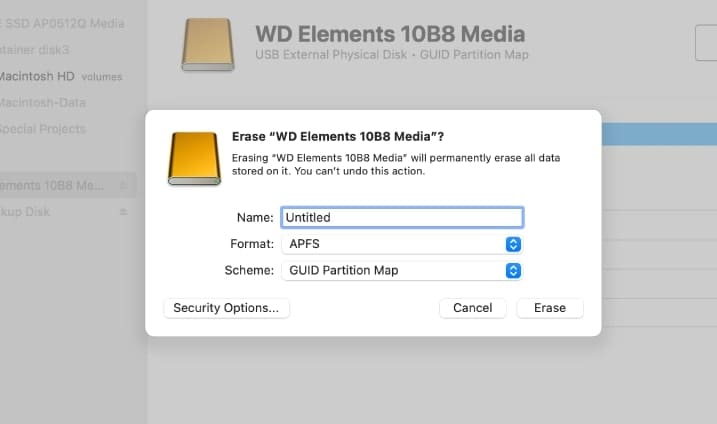It can be frustrating when you can't find your Mac's hard drive icon, as it's the gateway to all your important files, from system folders to personal documents. By default, newer versions of macOS, like Monterey or Ventura, often hide the Macintosh HD icon from the desktop and Finder, making file access less direct. If you need to quickly show the hard drive on your Mac, the good news is it's a simple settings adjustment.
This guide will walk you through the easy steps to show the hard drive on your Mac's desktop and in the Finder sidebar. Furthermore, we'll address what to do when your external hard drive isn't appearing, ensuring you can regain access to all your connected storage devices without any hassle.
| Problems | Solutions |
| How to Show Hard Drive Icon on Mac Desktop? | Go to Finder->Preferences->General.. |
| How to Find and Show External Hard Drive on Mac? | 1. Mount the External Hard Drive on Mac |
| 2. Remove All the Connected Peripherals | |
| 3. Reformat the External Device | |
| 4. Launch Disk Utility to Run First Aid | |
| How to Recover and Show Hard Drive Data on Mac? | Using Recoverit Data Recovery Tool |
Part 1. How to Show Hard Drive Icon on Mac Desktop?
It is the Finder's job for displaying the desktop and its icons, which include storage devices icon too. You can show or hide Mac's main hard drive from the desktop of your Mac with ease and all you need to do is to adjust some of the Finder options. If you want to keep your hard drives icon on the desktop so that you can access the data easily, then here's what you have to do to show hard drive on Mac.
To begin with, you need to first have the Finder option in the foreground. For this, check if there is the word "Finder" in your Mac menu bar. If no, then all you have to do is to tap on the "Finder" icon from the Dock of your Mac to appear it in the foreground.
Once you are able to do it, follow the below steps to show hard drive on a Mac desktop:
- Go to the Menu bar, and then, move to "Finder" -> "Preferences".

- Next, select the "General" tab when the Finder preferences window appears on your Mac screen. And check the box "Hard disks" under "Show these items on the desktop".

- Finally, the Mac hard drive icon should now appear on your desktop as shown in the below figure.

As you can see how much it is easy to show hard drives on your Mac desktop. Whenever you want quick access to the data on your Mac, all you have to do is double-click on your Mac HD drive from the desktop and you'll be navigated to the place where all of your Mac data is stored.
Part 2. How to Find and Show External Hard Drive on Mac?
Is your Mac not detecting the external hard drive? In many cases, an external hard drive not showing up on your Mac. There is no doubt that it is quite frustrating, especially when you want to transfer something very important right then. Besides this, there can be a change that data present on an external hard drive is corrupt, which is one of the reasons why your external hard drive not showing up on Mac.
The good news is that there are some solutions that can help you to come out of this problem and show external hard drive on Mac with ease. Let's look at them:
1. Mount the External Hard Drive on Mac
It could be the case that your Mac already detects an external hard drive, but it just not showing its icon on your desktop screen. If it is the case, then you can easily mount and access your drive again and all you have to do is to follow the below steps:
- To start with, move to the Finder menu and here, choose Preferences.
- In the Finder preferences window, choose the General tab.
- Here, you need to make sure that the "External disks" option under "Show these items on the desktop" is ticked.

Also, you can set your Mac to display an external hard drive in Finder. For this, go to "Finder">" Preferences">" Sidebar". Here, you need to tick the option "External disks" under the "Locations" menu.

This method will probably help you to show the connected external hard drive on your Mac. If it doesn't, then you can go for the next solution. And if you need to make a USB flash drive detected, the solutions might be more feasible: Fix USB not showing up on Mac.
2. Remove All the Connected Peripherals
When your Mac computer is connected to multiple peripherals, it may become confused. If this happens, you can resolve the issue by turning off your Mac and disconnecting all the connected devices. Then, restart your MacBook and connect the device one by one to see if it works.
3. Reformat the External Device
If the previously mentioned methods do not resolve the issue, it could be due to corruption or incorrect formatting of the device. In such cases, you can try reformatting the external storage device to restore its functionality.
Here are the steps to reformat the external storage device:
- Connect the device to your MacBook.
- Open Disk Utility.
- Choose the device from the sidebar and click on Erase.
- Enter the required information: Name, Format, and Scheme. Select APFS as the format and GUID Partition Map for the Scheme.
- Finally, click Erase to initiate the formatting process.

4. Launch Disk Utility to Run First Aid
There might be a case that your external hard drive is going through some problems you are unaware of it. In this case, you can try to resolve them yourself using Disk Utility to run the First Aid tool. Afterward, you can even access your files. The tool will inspect the disk for issues and errors and then, try to repair it as required. It is quite helpful when it comes to verifying and repairing a wide range of problems related to external and HD drive.
Here is the step-by-step guide on how you can run First Aid on your external hard drive:
- To start with, launch Disk Utility. You can search for it using Spotlight Search or go to "Finder">" Application">" Utility".
- After that, you need to check on an external hard drive. Next, click on the "First Aid" tab and choose "Run" to begin running diagnostics.

If First Aid tools become successful in fixing problems, then your external hard drive should now be available for you to mount. You can refer to the guide related to External Hard Drive Not Mounting on Mac for more solutions if you need.
What if the tool fails to repair issues? Then, your drive is badly broken or maybe formatted through a file system that your Mac can't read. In this way, we recommended that you should recover data from the damaged hard drive. Check out the next section to learn how to get back the hard disk data on Mac.
Bonus Tip: How to Recover and Show Hard Drive Data on Mac?
Have you ever wondered what if you found that you can't access the data stored on your Mac hard drive due to sudden power failure, or virus attack? Or if the above methods fail to fix "external hard drive not mounting Mac". In such cases, data recovery software can help you to easily get back hard drive data on your Mac.
1. Recoverit - The Best Software to Recover Mac Files:
Whenever you experience a data loss situation, Recoverit Data Recovery Mac will help you to retrieve it. This data recovery software will come in handy even when you've never made a backup of your device. You now know how to show hard drive on Mac. But knowing how you can recover the lost or deleted files from the drive is also necessary.
2. How to Recover Lost Files on Mac:
Step 1: Select a Location
Launch the software and select the drive from where the data files are lost. If you don't know which drive to search, tap on the "scan the entire disk" option, and hit the Scan button.

Step 2: Scan the Location
Typically, the software will run an All-Around Recovery scan and search for the lost and deleted files on the entire drive.

Step 3: Preview and Recover
When the scan completes, the files will be listed on the screen. The software will sort out the files according to format to make the search easier. You can select multiple files at a time and have a preview of them.

Part 1. Why You Can't See Hard Drive on Mac?
Well, there are a number of reasons why the hard drive not showing up on Mac. Here, we are going to mention the most common ones:
- Preference Issue: You may have not set preferences that make the hard drive visible on your Mac Finder or desktop.
- Connector Issue: It might be the case that you fail to connect the hard drive to your Mac USB port correctly. And maybe the cable you're using for connection is damaged or non-functional.
- Corruption of File system: It might also case that the file system of the hard drive is corrupt due to bad sectors, logical errors, etc. Sometimes, your hard drive file system damage leads to non-mounting HD in Finder.
- Hard drive failure: It might be the case that your drive is physically damaged due to component failure, head crash, or etc.
Conclusion
It can be concluded that showing hard drive on Mac is not that tough. You just have to careful during the process. And in case of a mishap, Recoverit is always here for your help so that you don't have to suffer from data loss situation.
FAQ
-
Q. How to Show Hard Drive on Mac?
Go to Menu bard and move to Finder. Click Preferences. Select the General tab on the Finder Preferences windows. Then, check the box ‘Hard disks’. After that, you will find the hard drive shows on your Mac desktop. -
Q. How to see all files on my Mac hard drive?
1. Click Go-Utilities-Terminal.
2. Type in the command: defaults write com.apple.Finder AppleShowAllFiles true
3. Press Enter.
4. Type in: killall Finder.
5. Press enter, then you will see all files on your Mac hard drive.
6. To undo the settings, simply type: defaults write com.apple.Finder AppleShowAllFiles false. Then press enter. -
Q. How to Find hidden hard drive on mac?
1. Go to Finder-Preferences-Sidebar.
2. Check the External Disks box.


 ChatGPT
ChatGPT
 Perplexity
Perplexity
 Google AI Mode
Google AI Mode
 Grok
Grok























